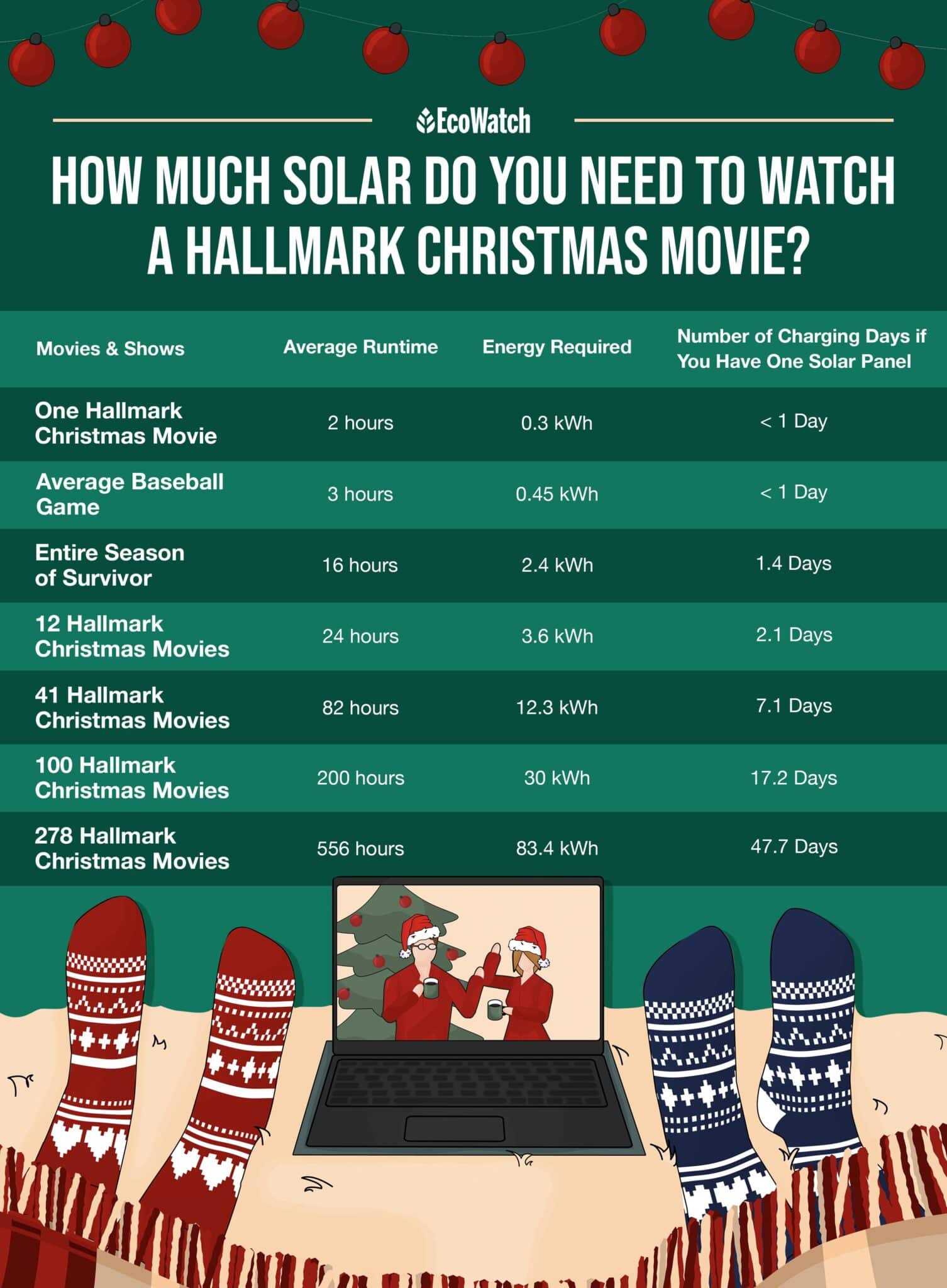
How Many Solar Panels Does It Take to Watch a Hallmark Christmas Movie?
What about all 41 released in 2021?

Prostock-Studio / iStock / Getty Images
We had a lot of questions when we heard that Hallmark was releasing 41 Christmas movies this year alone. First off, how? Secondly, do I have the time to watch them all? Do I have the energy to watch all 41 (mentally and physically) so as not to miss out on this timeless holiday tradition? How much electricity would that even require?
With the holidays approaching, we thought you might like the answer to the question us solar nerds are asking: how many solar panels does it take to watch a Hallmark Christmas movie?
Don’t celebrate Christmas or watch Hallmark movies? Fret not. This framework can help you understand the amount of power it takes to watch any movie, TV show, sports game or even provide electricity to your entire home.
How Much Electricity Does It Take to Power a TV?
The easiest place to start is by measuring the amount of electricity it requires to power your TV (to really do this right would require doing a full life-cycle assessment of your TV, cable box or console, etc., but we’ll keep things simple for now). In this context, electricity pulled to power your TV is measured in kilowatt-hours (kWh), a unit of energy equal to one kilowatt (1,000 watts) of power sustained for one hour. Think about kW as horsepower, and kWh as the speed of the car.
Say you had a 100-watt light bulb. By definition, a light bulb is labeled 100-watt because it requires 100 watt-hours of energy to run for one hour.
We can use the same method in measuring the amount of electricity necessary to power your TV. First, you’ll need to find the wattage of your TV. We’ll use an average size of about 150 W, which Payless Power says is the amount of power a 50-inch LCD TV.
Following this logic, we now know that it takes 150 watt-hours of energy to power this TV for one hour. Plasma TVs of the same size can be around 300 W, whereas an energy-efficient LED TV might be closer to 100 W.
Next question to answer would be: How long do we have to power our TVs with solar for some “A Princess for Christmas” action?
How Long Are Hallmark Christmas Movies?
Hallmark Christmas movies are made to air on TV and are about 90 minutes in length (aimed to line up with a two-hour airtime on cable). For simplicity’s sake, let’s use the two-hour figure.
Applying our simple logic, we know that powering a 150 W TV for two hours would require 300 watt-hours of electricity (150 watts x 2 hours).
- A three-hour baseball game would require 450 watt-hours (150 watts x 3 hours).
- A half-hour episode of Seinfeld would require 75 watt-hours (150 watts x .5 hours).
- Say you set a reasonable goal of limiting yourself to 10 Hallmark Christmas movies this season. Twenty hours of Hallmark movie magic would set you back 3,000 watt-hours of electricity, or 3 kWh (150 watts x 20 hours).
Starting to make sense?
So, How Many Solar Panels Does It Take To Watch a Hallmark Christmas movie?
We’ve measured our figure of 300 watt-hours of energy necessary to watch one Hallmark Christmas movie on a standard TV. So, how many watt-hours of electricity does one solar panel produce?
Our favorite solar panels average around 350 W. One 350-W solar panel will produce 350 watt-hours of electricity when receiving direct sunlight for one hour. This is slightly simplified, but assuming this panel gets around five hours of direct sunlight in a given day, one 350-W panel would generate 1,750 watt-hours of electricity (1.75 kWh). If you live in a very sunny region, factor in a little more conversion (maybe 2 kWh), and if you live further north your energy might be closer to 1.5 kWh.
For simplicity, let’s stick with the median figure of 1.75 kWh generated in one day. How many hours of energy would this provide your TV?
- Let’s first convert the 150 watt figure in kilowatts for our calculation: 150 W / 1,000 kW = .15 kW
- Next, divide the power generated by the panel by the kilowatts needed to power your TV: 1.75 kWh / .15 kW = 11.7 hours of TV.
- That means that, in one day, a single 350 W solar panel will produce enough energy to watch nearly six full-length Hallmark Christmas movies (5.85 to be exact).
Now the fun part. How many solar panels does it take to watch just the 41 Hallmark Christmas movies released in 2021? What about every Hallmark Christmas movie ever made? If you didn’t want to wait the number of days required, that figure is equivalent to how many panels you would need to generate that same amount of energy in one day.
(Assuming a constant of five hours of direct sunlight per day on a 350-watt solar panel)

EcoWatch Illustration by Devon Gailey
| Approximate Runtime | Energy Required | Number of Charging Days Needed if You Have One Solar Panel | |
|---|---|---|---|
| One Hallmark Christmas Movie | 2 hours | 0.3 kWh | <1 Day |
| Average Baseball Game | 3 hours | 0.45 kWh | <1 Day |
| Entire Season of Survivor | 16 hours | 2.4 kWh | 1.4 Days |
|
12 Hallmark Christmas Movies (A full day!) | 24 hours | 3.6 kWh | 2.1 Days |
|
41 Hallmark Christmas Movies (2021 Releases) | 82 hours | 12.3 kWh | 7.1 Days |
| 100 Hallmark Christmas Movies | 200 hours | 30 kWh | 17.2 Days |
| 278 Hallmark Christmas Movies | 556 hours | 83.4 kWh | 47.7 Days |
So, there you have it. On a sunny day, one solar panel is more than enough to provide the electricity you need to watch just one Hallmark Christmas movie. From there, we hope you have the tools necessary to calculate the solar energy necessary to power just about anything.
Powering Your Holidays with Solar
Using these formulas, you could even calculate how many solar panels you need to power your entire home. According to the EIA, in 2020, the average annual electricity consumption for a U.S. residential utility customer was roughly 30 kilowatt-hours (kWh) per day — the same amount of power it takes to watch 100 Hallmark Christmas movies.
With the same formula, we can divide 30 kWh by 1.75 (kWh generated by one panel in one day assuming the same constants) and get about 17 solar panels necessary to offset a home’s daily use, a 6 kW system. Add one or two panels if you live at a northern latitude, and subtract a few if you live farther south and get more sunlight per day.
Of course, panel efficiency and the actual amount of energy you consume will all factor into how many panels you actually need for your home. But it’s a safe bet that purchasing even one panel to power your television will help offset your home’s energy use — especially if you’re planning on binge-watching hours of iconic cinema to get you in the holiday spirit.

 233k
233k  41k
41k  Subscribe
Subscribe 